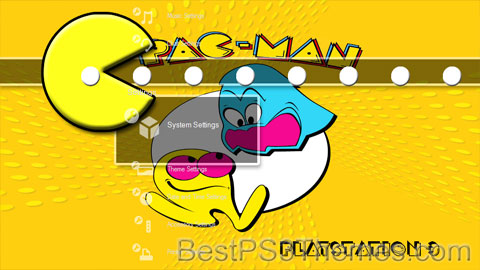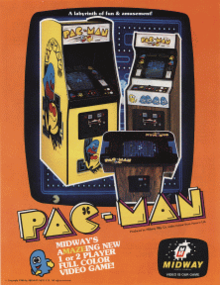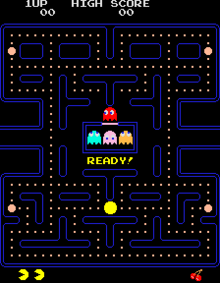Pac-Man theme by Dennis “F-Rott” Ferrand
Download: Pacman_2.p3t

(1 background)
| Pac-Man | |
|---|---|
 North American arcade flyer | |
| Developer(s) | Namco |
| Publisher(s) | |
| Designer(s) | Toru Iwatani |
| Programmer(s) | Shigeo Funaki Shigeichi Ishimura |
| Artist(s) | Hiroshi Ono[4] |
| Composer(s) | Shigeichi Ishimura Toshio Kai |
| Series | Pac-Man |
| Platform(s) | |
| Release | |
| Genre(s) | Maze |
| Mode(s) | 1-2 players alternating turns |
Pac-Man,[a] originally called Puck Man in Japan, is a 1980 maze video game developed and released by Namco for arcades. In North America, the game was released by Midway Manufacturing as part of its licensing agreement with Namco America. The player controls Pac-Man, who must eat all the dots inside an enclosed maze while avoiding four colored ghosts. Eating large flashing dots called "Power Pellets" causes the ghosts to temporarily turn blue, allowing Pac-Man to eat them for bonus points.
Game development began in early 1979, directed by Toru Iwatani with a nine-man team. Iwatani wanted to create a game that could appeal to women as well as men, because most video games of the time had themes of war or sports.[5][6] Although the inspiration for the Pac-Man character was the image of a pizza with a slice removed, Iwatani has said he rounded out the Japanese character for mouth, kuchi (Japanese: 口). The in-game characters were made to be cute and colorful to appeal to younger players. The original Japanese title of Puck Man was derived from the Japanese phrase paku paku taberu, which refers to gobbling something up; the title was changed to Pac-Man for the North American release.
Pac-Man was a widespread critical and commercial success, leading to several sequels, merchandise, and two television series, as well as a hit single, "Pac-Man Fever", by Buckner & Garcia. The character of Pac-Man has become the official mascot of Bandai Namco Entertainment.[7] The game remains one of the highest-grossing and best-selling games, generating more than $14 billion in revenue (as of 2016[update]) and 43 million units in sales combined, and has an enduring commercial and cultural legacy, commonly listed as one of the greatest video games of all time.
Gameplay[edit]

Pac-Man is an action[8] maze chase video game; the player controls the eponymous character through an enclosed maze. The objective of the game is to eat all of the dots placed in the maze while avoiding four colored ghosts—Blinky (red), Pinky (pink), Inky (cyan), and Clyde (orange)—who pursue Pac-Man. When Pac-Man eats all of the dots, the player advances to the next level. Levels are indicated by fruit icons at the bottom of the screen. In between levels are short cutscenes featuring Pac-Man and Blinky in humorous, comical situations.
If Pac-Man is caught by a ghost, he loses a life; the game ends when all lives are lost. Each of the four ghosts has its own unique artificial intelligence (A.I.), or "personality": Blinky gives direct chase to Pac-Man; Pinky and Inky try to position themselves in front of Pac-Man, usually by cornering him; and Clyde switches between chasing Pac-Man and fleeing from him.[9]
Placed near the four corners of the maze are large flashing "energizers" or "power pellets". When Pac-Man eats one, the ghosts turn blue with a dizzied expression and reverse direction. Pac-Man can eat blue ghosts for bonus points; when a ghost is eaten, its eyes make their way back to the center box in the maze, where the ghost "regenerates" and resumes its normal activity. Eating multiple blue ghosts in succession increases their point value. After a certain amount of time, blue-colored ghosts flash white before turning back into their normal forms. Eating a certain number of dots in a level causes a bonus item—usually a fruit—to appear underneath the center box; the item can be eaten for bonus points. To the sides of the maze are two "warp tunnels", which allow Pac-Man and the ghosts to travel to the opposite side of the screen. Ghosts become slower when entering and exiting these tunnels.
The game increases in difficulty as the player progresses: the ghosts become faster, and the energizers' effect decreases in duration, eventually disappearing entirely. An integer overflow causes the 256th level to load improperly, rendering it impossible to complete.[10] This is known as a kill screen.
Development[edit]
After acquiring the struggling Japanese division of Atari in 1974, video game developer Namco began producing its own video games in-house, as opposed to licensing them from other developers and distributing them in Japan.[11][12] Company president Masaya Nakamura created a small video game development group within the company and ordered them to study several NEC-produced microcomputers to potentially create games with.[13][14] One of the first people assigned to this division was a 24-year-old employee named Toru Iwatani.[15] He created Namco's first video game Gee Bee in 1978, which while unsuccessful helped the company gain a stronger foothold in the quickly-growing video game industry.[16][17] He assisted in the production of two sequels, Bomb Bee and Cutie Q, both released in 1979.[18][19]

The Japanese video game industry had surged in popularity with games such as Space Invaders and Breakout, which led to the market being flooded with similar titles from other manufacturers in an attempt to cash in on the success.[20][21] Iwatani felt that arcade games only appealed to men for their crude graphics and violence,[20] and that arcades in general were seen as seedy environments.[22] For his next project, Iwatani chose to create a non-violent, cheerful video game that appealed mostly to women,[23] as he believed that attracting women and couples into arcades would potentially make them appear to be much more family friendly in tone.[20] Iwatani began thinking of things that women liked to do in their time; he decided to center his game around eating, basing this on women liking to eat desserts and other sweets.[24] His game was initially called Pakkuman, based on the Japanese onomatopoeia term "paku paku taberu",[25] referencing the mouth movement of opening and closing in succession.[23]
The game that later became Pac-Man began development in early 1979 and took a year and five months to complete, the longest for a video game up to that point.[26] Iwatani enlisted the help of nine other Namco employees to assist in production, including composer Toshio Kai, programmer Shigeo Funaki, and hardware engineer Shigeichi Ishimura.[27] Care was taken to make the game appeal to a "non-violent" audience, particularly women, with its usage of simple gameplay and cute, attractive character designs.[26][22] When the game was being developed, Namco was underway with designing Galaxian, which used a then-revolutionary RGB color display, allowing sprites to use several colors at once instead of using colored strips of cellophane that was commonplace at the time;[26] this technological accomplishment allowed Iwatani to greatly enhance his game with bright pastel colors, which he felt would help attract players.[26] The idea for energizers was a concept Iwatani borrowed from Popeye the Sailor, a cartoon character that temporarily acquires superhuman strength after eating a can of spinach;[24] it is believed that Iwatani was partly inspired by a Japanese children's story about a creature that protected children from monsters by devouring them.[26] Frank Fogleman, the co-founder of Gremlin Industries, believes that the maze-chase gameplay of Pac-Man was inspired by Sega's Head On (1979), a similar arcade game that was popular in Japan.[28]
Iwatani has often claimed that the character of Pac-Man was designed after the shape of a pizza with a missing slice while he was at lunch; in a 1986 interview he said that this was only half-truth,[15] and that the Pac-Man character was also based on him rounding out and simplifying the Japanese character "kuchi" (口), meaning "mouth".[29][15] The four ghosts were made to be cute, colorful and appealing, using bright, pastel colors and expressive blue eyes.[26] Iwatani had used this idea before in Cutie Q, which features similar ghost-like characters, and decided to incorporate it into Pac-Man.[20] He was inspired by the television series Casper the Friendly Ghost and the manga Obake no Q-Taro.[24] Ghosts were chosen as the game's main antagonists because they were used as villainous characters in animation.[24] The idea for the fruit bonuses was based on graphics displayed on slot machines, which often use symbols such as cherries and bells.[30] Originally, Namco president Masaya Nakamura had requested that all of the ghosts be red and thus indistinguishable from one another.[31] Iwatani believed that the ghosts should be different colors, and he received unanimous support from his colleagues for this idea.[31] The ghosts were programmed to have their own distinct personalities, so as to keep the game from becoming too boring or impossibly difficult to play.[26][32] Each ghost's name gives a hint to its strategy for tracking down Pac-Man: Shadow ("Blinky") always chases Pac-Man, Speedy ("Pinky") tries to get ahead of him, Bashful ("Inky") uses a more complicated strategy to zero in on him, and Pokey ("Clyde") alternates between chasing him and running away.[26] (The ghosts' Japanese names are おいかけ, chase; まちぶせ, ambush; きまぐれ, fickle; and おとぼけ, playing dumb, respectively.) To break up the tension of constantly being pursued, humorous intermissions between Pac-Man and Blinky were added.[21] The sound effects were among the last things added to the game,[26] created by Toshio Kai.[22] In a design session, Iwatani noisily ate fruit and made gurgling noises to describe to Kai how he wanted the eating effect to sound.[22] Upon completion, the game was titled Puck Man, based on the working title and the titular character's distinct hockey puck-like shape.[12]
Release[edit]
Location testing for Puck Man began on May 22, 1980, in Shibuya, Tokyo, to a relatively positive[vague] fanfare from players.[24] A private showing for the game was done in June, followed by a nationwide release in July.[12] Eyeing the game's success in Japan, Namco initialized plans to bring the game to the international market, particularly the United States.[26] Before showing the game to distributors, Namco America made a number of changes, such as altering the names of the ghosts.[26] The biggest of these was the game's title; executives at Namco were worried that vandals would change the "P" in Puck Man to an "F", forming Fuck Man.[12][33] Masaya Nakamura chose to rename it to Pac-Man, as he felt it was closer to the game's original Japanese title of Pakkuman.[12] In Europe, the game was released under both titles, Pac-Man and Puck Man.[34]
When Namco presented Pac-Man and Rally-X to potential distributors at the 1980 AMOA tradeshow in November,[35] executives believed that Rally-X would be the best-selling game of that year.[12][36] According to Play Meter magazine, both Pac-Man and Rally-X received mild attention at the show. Namco had initially approached Atari to distribute Pac-Man, but Atari refused the offer.[37] Midway Manufacturing subsequently agreed to distribute both Pac-Man and Rally-X in North America, announcing their acquisition of the manufacturing rights on November 22[38] and releasing them in December.[39]
Ports[edit]
Pac-Man was ported to several home video game systems and personal computers; the most infamous of these is the 1982 Atari 2600 conversion, designed by Tod Frye and published by Atari, Inc.[40] This version of the game was widely criticized for its inaccurate portrayal of the arcade version and for its peculiar design choices, most notably the flickering effect of the ghosts.[41][42][43] However, it was a commercial success, selling over seven million copies. Atari released versions for the Intellivision, VIC-20, Commodore 64, Apple II, IBM PC compatibles, TI-99/4A, ZX Spectrum, and the Atari 8-bit computers. A port for the Atari 5200 was released in 1983, a version that is considered as a significant improvement over the Atari 2600 version.[44]
Namco released a version for the Nintendo Famicom in 1984 as one of the console's first third-party titles,[45] as well as a port for the MSX computer.[46] The Famicom version was later released in North America for the Nintendo Entertainment System by Tengen, a subsidiary of Atari Games. Tengen produced an unlicensed version of the game in a black cartridge shell, released during a time when Tengen and Nintendo were in disagreements over the latter's stance on quality control for its consoles; this version was re-released by Namco as an official title in 1993, featuring a new cartridge label and box. The Famicom version was released for the Famicom Disk System in 1990 as a budget title for the Disk Writer kiosks in retail stores.[45] The same year, Namco released a port of Pac-Man for the Game Boy, which allowed for two-player co-operative play via the Game Link Cable peripheral. A version for the Game Gear was released a year later, which likewise enabled support for multiplayer. In celebration of the game's 20th anniversary in 1999, Namco re-released the Game Boy version for the Game Boy Color, bundled with Pac-Attack and titled Pac-Man: Special Color Edition.[47] The same year, Namco and SNK co-published a port for the Neo Geo Pocket Color, which came with a circular "Cross Ring" that attached to the d-pad to restrict it to four-directional movement.[48]
In 2001, Namco released a port of Pac-Man for various Japanese mobile phones, being one of the company's first mobile game releases.[49] The Famicom version of the game was re-released for the Game Boy Advance in 2004 as part of the Famicom Mini series, released to commemorate the 25th anniversary of the Famicom; this version was released in North America and Europe under the Classic NES Series label.[50] Namco Networks released Pac-Man for BREW mobile devices in 2005.[51] The arcade original was released for the Xbox Live Arcade service in 2006, featuring achievements and online leaderboards. In 2009 a version for iOS devices was published; this release was rebranded as Pac-Man + Tournaments in 2013, featuring new mazes and leaderboards. The NES version was released for the Wii Virtual Console in 2007. A Roku version was released in 2011,[52] alongside a port of the Game Boy release for the 3DS Virtual Console. Pac-Man was one of four titles released under the Arcade Game Series brand, which was published for the Xbox One, PlayStation 4 and PC in 2016.[53] In 2021, according to Nintendo Direct, it was announced that Hamster Corporation would release Pac-Man, along with Xevious, for the Nintendo Switch and PlayStation 4 as part of its Arcade Archives series, marking the first two Namco games to be included as part of the series.
Pac-Man is included in many Namco compilations, including Namco Museum Vol. 1 (1995),[54] Namco Museum 64 (1999),[55] Namco Museum Battle Collection (2005),[56] Namco Museum DS (2007), Namco Museum Essentials (2009),[57] and Namco Museum Megamix (2010).[58] In 1996, it was re-released for arcades as part of Namco Classic Collection Vol. 2, alongside Dig Dug, Rally-X and special "Arrangement" remakes of all three titles.[59][60] Microsoft included Pac-Man in Microsoft Return of Arcade (1995) as a way to help attract video game companies to its Windows 95 operating system.[61] Namco released the game in the third volume of Namco History in Japan in 1998.[62] The 2001 Game Boy Advance compilation Pac-Man Collection compiles Pac-Man, Pac-Mania, Pac-Attack and Pac-Man Arrangement onto one cartridge.[63] Pac-Man is a hidden extra in the arcade game Ms. Pac-Man/Galaga - Class of 1981 (2001).[64][65] A similar cabinet was released in 2005 that featured Pac-Man as the centerpiece.[66] Pac-Man 2: The New Adventures (1993) and Pac-Man World 2 (2002) have Pac-Man as an unlockable extra. Alongside the Xbox 360 remake Pac-Man Championship Edition, it was ported to the Nintendo 3DS in 2012 as part of Pac-Man & Galaga Dimensions.[67] The 2010 Wii game Pac-Man Party and its 2011 3DS remake include Pac-Man as a bonus game, alongside the arcade versions of Dig Dug and Galaga.[68][69] In 2014, Pac-Man was included in the compilation title Pac-Man Museum for the Xbox 360, PlayStation 3 and PC, alongside several other Pac-Man games.[70] The NES version is one of 30 games included in the NES Classic Edition.[71]
Reception[edit]
| Publication | Score |
|---|---|
| AllGame | |
| Computer and Video Games | 9/10 (Atari 400/800)[74] |
| Eurogamer | 10/10 (Virtual Console)[75] |
| IGN | 7/10 (Neo Geo Pocket)[76] |
| Computer Games | Classic (computers)[77] Positive (IBM PC)[78] |
| Mean Machines | 80% (Game Boy)[79] |
| Popular Computing Weekly |
| Publication | Award |
|---|---|
| Arcade Awards (1981) | Best Commercial Arcade Game[81] |
| Video Software Dealers Association (VSDA) | Best Videogame[82] |
One Reply to “Pac-Man #2”Comments are closed. |

Never mind. Seemed to be a wonky thing. Enjoy!